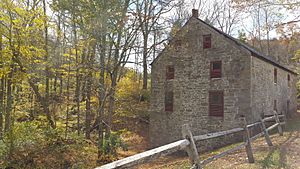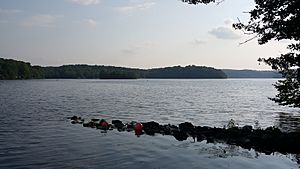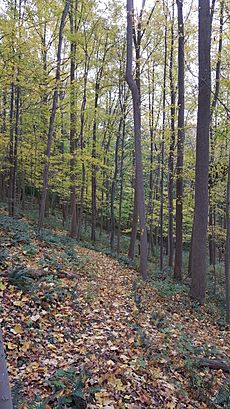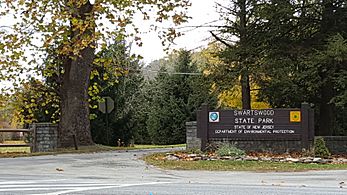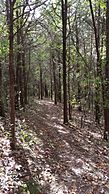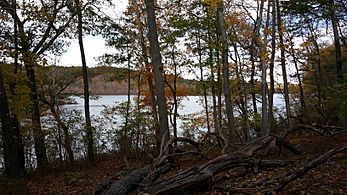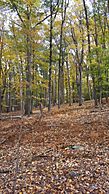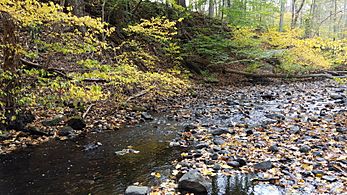Swartswood State Park facts for kids
Quick facts for kids Swartswood State Park |
|
|---|---|

Swartswood Lake looking south at sunset, July 2015
|
|
| Lua error in Module:Location_map at line 420: attempt to index field 'wikibase' (a nil value). | |
| Location | Stillwater and Hampton townships, Sussex County, New Jersey, United States |
| Nearest town | Newton, New Jersey |
| Area | 3,460 acres (14.0 km2) |
| Elevation | 502 feet (153 m) |
| Created | 1915 |
| Operated by | New Jersey Division of Parks and Forestry |
| Open | year round |
Swartswood State Park is a large protected area in Sussex County, New Jersey. It covers about 3,460 acres (14 square kilometers). This park was created in 1915 by New Jersey's Forest Park Reservation Commission. It was the very first state park in New Jersey made for people to enjoy outdoor fun.
The park's main attraction is Swartswood Lake, which is the third-largest freshwater lake in New Jersey. This lake, along with the smaller Little Swartswood Lake, was formed by glaciers melting about 20,000 years ago. Today, the park is managed by the New Jersey Division of Parks and Forestry. It's open all year for many activities like hiking, swimming, boating, and camping. You can also go fishing and hunting here.
Contents
How Swartswood State Park Began
In 1905, Governor Edward C. Stokes started a group called the Forest Park Reservation Commission. Their job was to buy land in New Jersey to create parks and forest reserves. At first, they focused on protecting forests for their wood.
However, in 1908, the state forester, Alfred Gaskill, suggested making parks for fun. He believed that forests should also be "playgrounds" for people, especially those living in towns and cities.
Buying the Lake for Public Use
Before the park was created, a man named Andrew Albright, Sr. owned Swartswood Lake. He bought it in 1888 and tried to stop people from fishing there for free. He even fought against the state's efforts to open it up to the public.
After Albright's death in 1905, his children, Andrew Albright, Jr. and Elizabeth Spurr, sold the lake to the state. In August 1914, they sold 544 acres, including the lake, for $30,000. The deal was finished on June 30, 1915. This purchase included the 520-acre lake and about 20 acres of land. This land provided places for boats to launch and areas for picnics and other fun.
The park's creators wanted Swartswood to be a "public playground." They planned to have boat rentals and picnic spots for many people to use. They also planned to stock the lake with fish. Because it focused on fun activities, Swartswood is known as New Jersey's first state park. The park grew over time with more land purchases in 1916 and 1941.
Protecting the Lake's Water Quality
Since 1961, New Jersey's Green Acres Program has helped expand protected areas like Swartswood State Park. This program helps buy land to connect the park with other wildlife areas. This protects animals like bobcats and black bears.
In 1992, local people started the Swartswood Lakes and Watershed Association. This group works to keep the water in Swartswood and Little Swartswood Lakes clean. They also want to make sure the lakes stay open for fun activities. They work with the State Park Service and universities on projects to protect the water.
Park's Location and Natural Features
Swartswood State Park is a large protected area in Stillwater and Hampton townships, New Jersey. It sits about 502 feet (153 meters) above sea level. The park is located along County Route 619, which is also called East Shore Drive.
Lakes and Streams
The main part of the park is Swartswood Lake, a 520-acre glacial lake. It is the third-largest freshwater lake in New Jersey. The lake is about 3 miles long (north to south) and 1 mile wide (east to west). It is usually about 22 feet deep, but can be as deep as 42 feet.
The park also has other water bodies. These include Neldon's Brook and smaller lakes like Little Swartswood Lake, which is 84 acres. Other small lakes are Duck Pond, Spring Lake, Willow Crest Lake, and Frog Pond. All the water in the park eventually flows into the Paulins Kill river, which then flows into the Delaware River.
How the Land Was Formed
Swartswood State Park is located in the Kittatinny Valley. This valley is part of a much larger valley system called the Great Appalachian Valley. The land here was shaped by glaciers from the Wisconsin glaciation period. These glaciers melted and left behind materials that formed the soil and hills.
The lake itself was formed when a river valley was blocked by glacial deposits. Swartswood Lake is a glacial lake, which means it was created by ice. Over a very long time, maybe 100,000 years, glacial lakes naturally change into bogs.
The ground beneath the lake and valley is made of a thick layer of rock called the Martinsburg Formation. This layer is about two miles thick. It's made of soft sedimentary rocks like slate, sandstone, and shale. These rocks formed from deep ocean floor deposits between 540 and 400 million years ago.
To the east of the lake, there's a ridge of harder bedrock. This rock formed from ancient continents that separated and were sometimes covered by shallow seas. Over millions of years, layers of marine sediment and rock built up. Then, huge forces from mountain building events, called "orogenies," pushed these rocks up. The Appalachian or Alleghanian orogeny, which happened between 325 and 260 million years ago, created the mountains we see today.
Park's Wildlife and Plants
Duck Pond in the park is a special kind of wetland called a vernal pool. It's a low spot in the forest that fills with water but isn't connected to a stream. The soil keeps the water from draining away easily. This pool is home to many plants and animals. You can find wood frogs, spring peepers, and three types of salamanders here: the Jefferson salamander, spotted salamander, and marbled salamander.
Birdwatchers can spot many different waterfowl species at Swartswood. These include pied-billed grebes, wood ducks, ring-necked ducks, and ruddy ducks. Sometimes, you might even see a bald eagle!
The lake also has some invasive species, which are plants or animals that are not native and can harm the local environment. One example is the water chestnut.
Fun Things to Do at Swartswood State Park
Outdoor Adventures
The park has ten hiking trails that offer different views of Swartswood Lake and other lakes. These trails have various levels of difficulty and different types of land. You can walk, mountain bike, or even ride horses on some trails. In the winter, you can go cross-country skiing and sledding. Some trails have special spots called bird blinds. These allow visitors to watch birds without disturbing them.
You can go swimming, boating, and sunbathing on the lake. You can rent canoes, kayaks, and sailboats. There are several places around the lake to launch your boat. Only boats with electric motors are allowed; gasoline motors are not permitted. Swimming is allowed at the beach during the summer, from Memorial Day weekend to Labor Day weekend, when lifeguards are on duty. The beach also has a snack stand and a bathhouse.
Camping and Picnics
Swartswood State Park has 65 campsites for tents and trailers. Each site can hold up to six people and includes a fire ring, picnic table, and lantern holder. The park also has five yurt camping sites. Yurts are round, tent-like structures. All campsites are within walking distance of flush toilets and showers.
There are picnic areas with tables and grills at several pretty spots around the lake. You can only use charcoal fires for grilling. The park also has playgrounds and courts for volleyball and basketball.
Keen's Grist Mill Site
In 1838, a local resident named George Keen built a grist mill at the end of Swartswood Lake. A grist mill is a place where grain is ground into flour. This mill was built where an older mill once stood. Keen's mill used a 16-foot waterfall and a water wheel to power its grinding stones. After Keen died, his son John W. Keen ran the mill for 32 years.
Later, the mill property was bought by Dr. William H. Vail, who used the mill's dam to control water for a power plant downstream. Eventually, the state Department of Environmental Protection bought the mill property in 1976. It then became part of Swartswood State Park.
The park's 1.2-mile Grist Mill Trail starts at this site. The trail has red cedar trees, steep parts, and great views of the southern part of the lake.
Hunting and Fishing Opportunities
You can go hunting and fishing in certain areas of the park. Hunters and anglers need to have the right state licenses and follow the rules set by the New Jersey Division of Fish and Wildlife. Hunting is allowed in the park areas east of County Route 619, which is about 45% of the park.
Common animals found for hunting include pheasants, ruffed grouse, wild turkeys, gray squirrels, eastern cottontail rabbits, and white-tailed deer.
Swartswood Lake is known as one of the best lakes in New Jersey for walleye fish. The lake is stocked with brown, rainbow, and brook trout in the spring. You can also find channel catfish, largemouth bass, smallmouth bass, chain pickerel, perch, and panfish. In the winter, you can go ice fishing for pickerel, perch, and brown trout.
Images for kids


